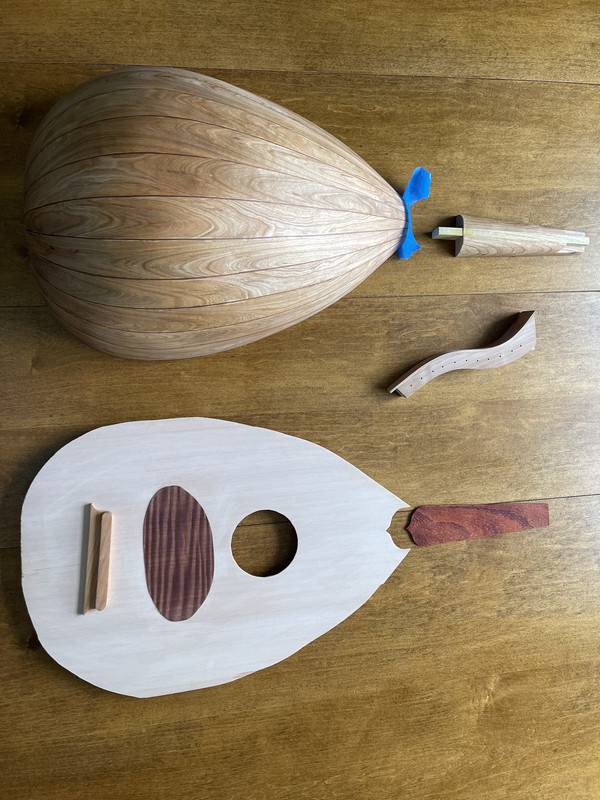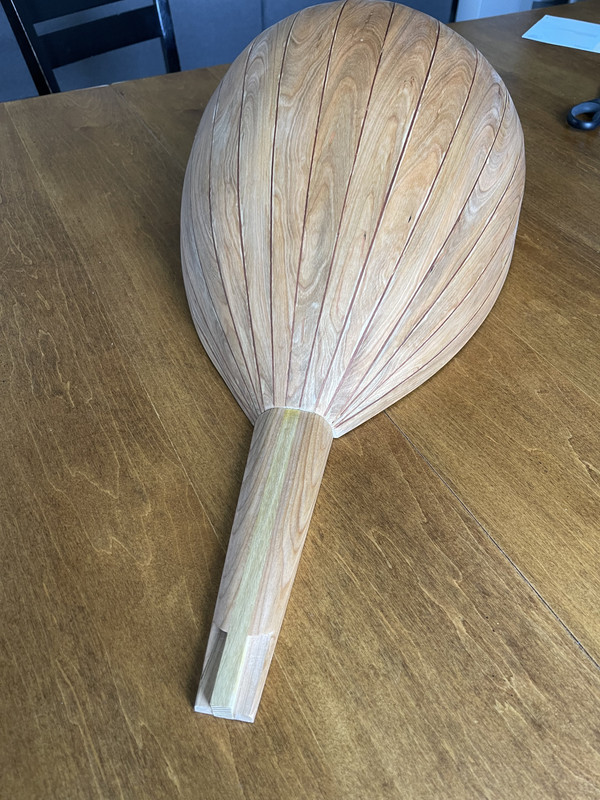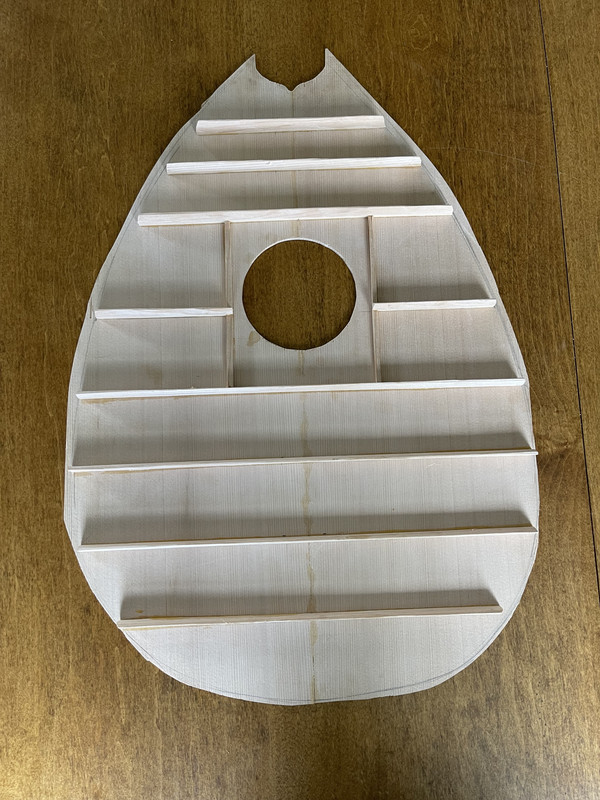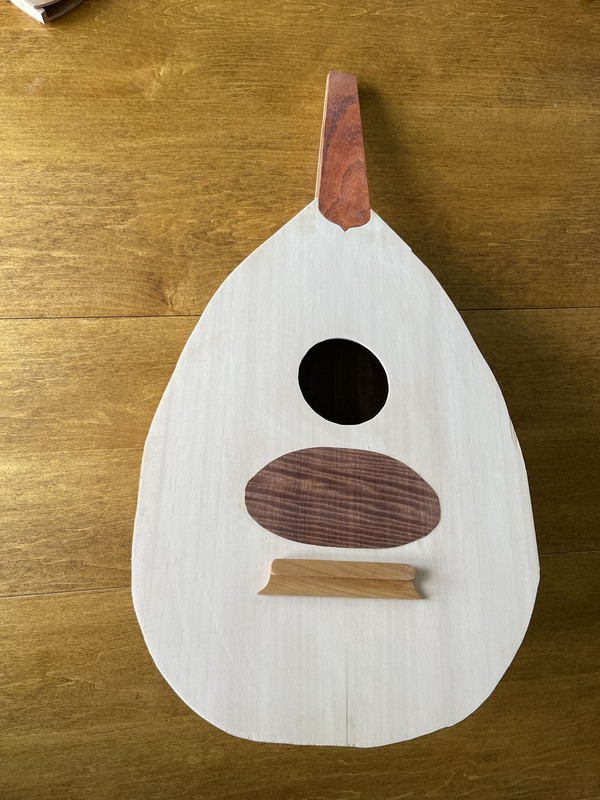
ElderOud - 4-26-2025 at 04:28 AM
Hello everyone,
I’m currently trying to build an oud. My main goal today is to share something you might find interesting, and talk a bit about my experience.
It all started several weeks ago when a friend of mine started learning Turkish. During one of her classes the teacher introduced them to Turkish
music and the oud. While it would be an exaggeration to say that she fell in love with it, she did like it quite a lot and decided she wanted to learn
the oud. I heard a lot about it over the next several days, and it did pique my interest. I’m a pianist but I’ve always been a sucker for
microtonality.
One day, I decided to do my own research, and the first thing I found was a blog of somebody making their own oud. I’m sure many of you have read
it, the first part can be found here but the end I had to read on the Wayback Machine. I’m a novice woodworker and this looked like the coolest project ever. And so I, always
being one to take on big projects without prior experience, decided to build one myself.
The reason that I said my goal is mainly to entertain is because I’m almost done. I’ll happily take any advice or criticism though, I intend to
try again a little bit later. Because I’m on a tight budget, I decided not to buy Dr. Oud’s book, though I definitely will for my next attempt. My
main resources were the blog above, this forum, and this website. I understand that probably means I missed important details and did things wrong, but for now I’m ok with that. This has been
such a fun project, and I’ve learned a lot.
Because of my budget, I decided to do all I could to use what I had already. The bowl is made of butternut, hewn from a tree in my backyard several
years ago and drying in my barn ever since. Besides the fingerboard, almost everything else is cherry gifted by a woodworker friend, and the
soundboard is the only wood I bought. I went to the building supply store and found the tightest, most quartersawn ceder board I could. Ceder wasn’t
my first choice, but I couldn’t afford the acoustic quality spruce. I guess we’ll see soon how it sounds.
My woodworker friend mentioned above mostly works with veneers, and gave me some really cool pieces to use. The pickguard and soundboard accent is
fiddlebacked makore, african cherry; and the fingerboard is African Padauk. I know that’s not traditional, but it is pretty, and hard enough. The
only things I bought were the ebony pegs and a set of strings. All in all I’ve only spent around $60 on it. Of course at that price point I don’t
expect an heirloom quality instrument, but I like to imagine it as paying $60 for 50+ hours of fun. Pretty good deal when you think of it like
that.
I regret not taking more pictures during the process, but attached are the current state and when it’s finished I’ll post updated pictures and a
video of the sound. I’m happy to answer questions about any process or detail. I’m well aware of several blunders, but I’ll explain as they get
pointed out, so please see what you can find . When it’s finished I have been
planning on gifting it to my turkish-learning friend, but if it sounds bad I won’t. There’s no pressure though because she doesn’t know I’m
building it.
. When it’s finished I have been
planning on gifting it to my turkish-learning friend, but if it sounds bad I won’t. There’s no pressure though because she doesn’t know I’m
building it.
Lastly, I’d like to acknowledge that I’m just a white guy from New England. This isn’t my heritage and I hope this isn’t taken the wrong way.
I’ve always found that the best connections I can form with people is through exploring their culture, and so I’ve been using this as an
opportunity to learn, not just as a woodworking project.
Cheers!

Here is the current state. The pegbox is the most incomplete part because I broke the first one I made. The soundboard is oversized for the bowl, not
yet trimmed.

dry-fit of bowl and neck

Soundboard and supports

Kinda how it'll look, but it will have more of the cool veneer below the bridge.
Brian Prunka - 4-26-2025 at 08:49 AM
Very cool and impressive project! Will be interesting to hear how it sounds.
I'm not a luthier, so the following thoughts are just from being a longtime player.
I'm curious how you settled on a single soundhole. Are you intending this for Arabic tuning or Turkish? What is the scale length?
Turkish ouds universally have three sound holes, Arabic ouds may have one or three. Bear in mind that the holes function to make the bowl resonate,
and the total area of all holes is relevant to the frequencies that will be emphasized.
Looking at these photos, that soundhole looks too small to me for a single soundhole. You might consider adding the small soundholes, especially if
you are intending this for Turkish tuning.
Your bracing looks maybe a bit tall - not sure if you plan to shave it down at all. Arabic ouds often have taller braces, different luthiers have
varying approaches here as the bracing is a key element in the sound produced. Some also shave/contour the braces.
I think that the "beard" (the end of the fingerboard that inlays into the face) is typically a separate piece as there is a slight angle where the
neck meets the body. Could be wrong about that but maybe something to look into.
paulO - 4-26-2025 at 09:09 AM
Very cool looking choice of woods. Can't wait to hear how it sounds !!! Thanks for sharing.
Regards,
Paul
ElderOud - 4-26-2025 at 03:31 PM
Thanks for the feedback! Almost all of my dimensions came from the "technical construction of the oud" page, and I just reread it and yes, I missed
the two smaller holes. The big one has a diameter of 9cm, and the smaller ones I now plan on being 4.4cm. The scale length is 58.5cm, because my neck
is 19.5cm long and I read that it should be a third of the scale. Is the fingerboard supposed to be proud of the soundboard? I couldn't tell from any
pictures. The blog I read made the beard a separate piece but I was lazy and combined them. I guess this is what I get for never having seen an oud in
person. Yes I plan on using Turkish tunings. Thanks again.
Brian Prunka - 4-27-2025 at 08:37 AM
The most traditional approach is to have the fingerboard inlaid flush to the soundboard. Many modern designs have the fingerboard on top of the
soundboard but only if it extends fully all the way to the soundhole.
Neck 1/3 of scale is correct and 58.5cm is standard Turkish scale length, so you're good there. With the small holes added you should be good!

 . When it’s finished I have been
planning on gifting it to my turkish-learning friend, but if it sounds bad I won’t. There’s no pressure though because she doesn’t know I’m
building it.
. When it’s finished I have been
planning on gifting it to my turkish-learning friend, but if it sounds bad I won’t. There’s no pressure though because she doesn’t know I’m
building it. 


